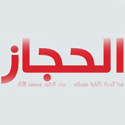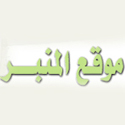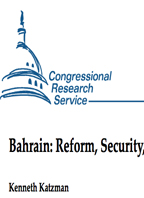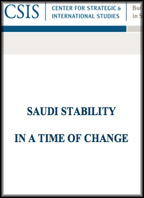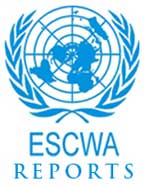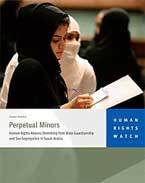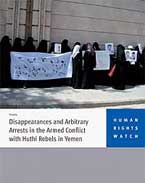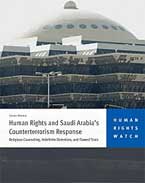UNCLAS SECTION 01 OF 13 SANAA 000295
SENSITIVE
SIPDIS
DEPT FOR INL, DRL, PRM, G/TIP LPENA AND SAHLUWALIA, NEA/ARP
AMACDONALD AND LFREEMAN, NEA/RA MADLER
USAID FOR CKISCO
E.O. 12958: N/A
TAGS: KTIP ELAB KCRM KFRD KWMN PGOV PHUM PREF SMIG
SUBJECT: YEMEN: TENTH ANNUAL TRAFFICKING IN PERSONS (TIP) REPORT
REF: A. STATE 2094
¶B. 09 SANAA 1936
¶C. 09 SANAA 1998
¶D. 09 SANAA 2219
The entire text of this report is Sensitive But Unclassified
(SBU).
Embassy Sana’a TIP POC:
Faith Meyers, Acting Political Chief
967-1-755-2398
Embassy Sana’a TIP POC (Alternate):
Walker Murray, Cultural Affairs Officer
967-1-744-2476
TIP Reporting Hours:
Faith Meyers, FS-5: 20 hours
Walker Murray, FS-5: 20 hours
AK Muhsen, FSN-11: 20 hours
¶25. (SBU) THE COUNTRY’S TIP SITUATION
¶A. What is (are) the source(s) of available information on
human trafficking? What plans are in place (if any) to
undertake further documentation of human trafficking? How
reliable are these sources?
There is a serious deficit in reliable statistical data on
trafficking, but the government plans to undertake further
documentation in 2010. The Ministry of Social Affairs has
contracted Ushari Khalil, a scholar with past experience
working on trafficking issues with the UN in southern Sudan,
to complete a national situation report and evaluation of
current government interventions. The government-affiliated
Saleh Foundation maintains a registry for tracking children
returning from Saudi Arabia, although this only captures a
small fraction of total trafficking victims in the country.
The Ministry of Social Affairs and Labor (MOSAL) said that
fewer children were trafficked to Saudi Arabia in 2009 (602)
compared to 2008 (900), but these figures are inaccurate and
represent only the small number of trafficking victims that
found their way to one of two children’s rehabilitation
centers in Yemen. According to a joint UNICEF-MOSAL study,
security officials have prevented 1500 children from being
trafficked from 2004-2009 (no further breakdown available).
Local NGO Seyaj said a study from 2007 suggested there were
700,000 children in forced-labor conditions in Yemen and they
estimate that the number is now double that figure.
According to Seyaj, the magnitude of human trafficking in
Yemen is directly related to the economic and security
conditions in the country, both of which have deteriorated in
recent years, increasing the vulnerability of Yemenis to
trafficking.
¶B. Is the country a country of origin, transit, and/or
destination for men, women, or children subjected to
conditions of commercial sexual exploitation, forced or
bonded labor, or other slave-like conditions? Are citizens
or residents of the country subjected to such trafficking
conditions within the country? If so, does this internal
trafficking occur in territory outside of the government’s
control (e.g., in a civil war situation)? From where are
people recruited or from where do they migrate prior to being
subjected to these exploitative conditions? To what other
countries are people trafficked and for what purposes?
Provide, where possible, numbers or estimates for each group
of trafficking victims. Have there been any changes in the
TIP situation since the last TIP Report (e.g., changes in
destinations)?
Yemen is a point of origin (Yemenis trafficked mainly to the
Gulf and Horn of Africa nationals trafficked upon arrival in
Yemen), transit (Horn of Africa nationals trafficked to the
Gulf), and destination (Horn of Africa nationals trafficked
SANAA 00000295 002 OF 013
to Yemen).
According to IOM, children (mostly boys) are smuggled to
Saudi Arabia for forced begging, unskilled labor and
street-vending. Children are recruited from the governorates
of Dhamar, Hajja, Rayma, Taiz, Hudeidah, Mahweet, Ibb, Lahj,
Dhale’ and Sa’ada. Although Saudi Arabia is the primary
destination for children trafficked from Yemen, a small
number are trafficked to Oman. Trafficking to Saudi Arabia
is especially high during the season of Umra and the Hajj
(pilgrimage to Mecca).
Internal trafficking occurs, both in areas under and somewhat
outside of the government’s control (e.g. Sa’ada). Children
are recruited from their families, and the parents reach an
agreement with an agent to receive a certain monthly share of
their child’s earnings. Many victims are young girls from a
variety of rural governorates sent to hotels in Aden, Sana’a,
Taiz, Hudeidah and other cities for sexual exploitation.
According to Seyaj, local media reports and the Egyptian
government, at least 10 Yemeni children were trafficked to
Egypt for organ harvesting in 2009. The children were
repatriated to Yemen after Egyptian authorities discovered
the trafficking ring.
There were many reports during the year that Somali refugee
women were trafficked to Aden for prostitution and forced to
live in squalid conditions.
Since the last TIP report, the war in northern Yemen
intensified and spread, although a ceasefire was declared on
February 12. Local NGO Shawthab Foundation reports that
although the Saudi entrance into the conflict has reduced the
ability of traffickers to penetrate the Yemeni-Saudi border,
people inside the conflict zone are extremely vulnerable to
trafficking because their livelihoods have been destroyed.
Shawthab says that it interviewed child trafficking victims
who were recruited from official IDP camps. Seyaj reports
that there are approximately 150,000 children in Sa’ada
governorate, which has almost no functioning schools and a
legal system even more dysfunctional than in the rest of the
country. Of the estimated 250,000 IDPs from the conflict, 70
to 80 percent live outside of official camps.
¶C. To what kind of conditions are the trafficking victims
subjected?
Children are deprived of all rights; they do not attend
school and they cannot get access to medical care when
necessary, although they are at high risk for STDs, skin
diseases and other ailments. They often experience
slavery-like conditions, including domestic abuse, and may be
remunerated only with room and board. Children trafficked
for purposes other than sexual exploitation often experience
sexual exploitation at the hands of traffickers, border
patrols, other security officials, and their employers.
Their status in Saudi Arabia is illegal, and they cannot
report abuses and crimes to the authorities. When crossing
the Saudi border back into Yemen to visit their families,
they are subjected to robbery and extortion by border guards.
Many of the border crossings used by traffickers are in
dangerous desert areas where trafficking victims are
subjected to the risks of dehydration, starvation, and
exposure. Trafficked children told Shawthab that Saudi
border guards have hung children’s severed heads from trees
near the border as a warning to other children thinking about
crossing the border illegally.
In the conflict zone in northern Yemen, NGOs have collected
evidence that children are forced to fight both with the
government forces and with the Houthis (see 33 for more
details on child soldiers in Sa’ada).
Street children in the major cities work in arduous,
dangerous jobs unsuitable for their age and physical
SANAA 00000295 003 OF 013
capabilities. They are subject to exploitation by
individuals and gangs involved in the sex trade. They face
verbal and physical abuse and are subject to kidnapping,
trafficking and sexual harassment.
¶D. Vulnerability to TIP: Are certain groups of persons more
at risk of human trafficking (e.g., women and children, boys
versus girls, certain ethnic groups, refugees, IDPs, etc.)?
If so, please specify the type of exploitation for which
these groups are most at risk.
Young women and boys are more at risk for sexual exploitation
and domestic servitude; disabled children are more at risk
for forced begging. Children are also used to smuggle drugs
across the border into Saudi Arabia.
Refugees and economic migrants from the Horn of Africa are
also vulnerable to trafficking. Many choose to travel to
Yemen with hopes of working in other Gulf countries, but once
they reach Yemen are trafficked into prostitution and
domestic servitude. Others are trafficked to Yemen with
false promises of comfortable work as domestic servants, but
upon arrival are forced into prostitution or domestic
servitude.
¶E. Traffickers and Their Methods: Who are the
traffickers/exploiters? Are they independent business
people? Small or family-based crime groups? Large
international organized crime syndicates? What methods are
used to gain direct access to victims? For example, are the
traffickers recruiting victims through lucrative job offers?
Are victims sold by their families, or approached by friends
of friends? Are victims “self-presenting” (approaching the
exploiter without the involvement of a recruiter or
transporter)? If recruitment or transportation is involved,
what methods are used to recruit or transport victims (e.g.,
are false documents being used)? Are employment, travel, and
tourism agencies or marriage brokers involved with or
fronting for traffickers or crime groups to traffic
individuals?
The traffickers are both individuals and, less frequently,
organized gangs. Seyaj claims that most of the gangs are run
by Saudis. Their agents know local communities and seek out
children with lucrative potential. For sex trafficking they
recruit children based on their “degree of beauty.” They
also recruit children with disabilities because they earn
more as street beggars.
Local NGO Democracy School reports that many of the
traffickers are former trafficked children. They become
experts at crossing the border and develop contacts in Saudi
who will pay for trafficked labor.
Both Shawthab and Seyaj report that the victims are often
sold by their families, in exchange for a promised monthly
remittance. Many of the trafficking victims are girls who
enter into “temporary marriages” with Saudi tourists.
Sometimes the traffickers promise the family that a rich
sheikh from the Gulf will sponsor their disabled child for
special education or physical rehabilitation.
Other victims are “self-presenting,” young people who seek
work opportunities outside of their villages and are then
subjected to forced-labor conditions. It is common for
impoverished families to send an older child to work in Saudi
Arabia in what they believe will be a decent job opportunity
to help the family financially. Some children already
working in the streets as beggars or vendors hear about
better opportunities in Saudi Arabia that sound tempting.
Somali pirates capitalize on the instability in the Horn of
Africa to traffic people across the Gulf of Aden to Yemen.
Piracy, human trafficking and illegal smuggling are
intertwined and many of the same criminals engage in all
three practices.
SANAA 00000295 004 OF 013
¶26. (SBU) SETTING THE SCENE FOR THE GOVERNMENT’S ANTI-TIP
EFFORTS
¶A. Does the government acknowledge that human trafficking is
a problem in the country? If not, why not?
According to Higher Council for Motherhood and Childhood
(HCMC) General Secretary Dr. Nafisa H. al-Jaifi, the
government acknowledges that human trafficking is a problem
in the country. Prime Minister Ali al-Mujawwar convened a
meeting of the entire cabinet to develop a national strategy
for addressing trafficking in persons, which was ratified by
the Council of Ministers on March 31, 2009.
¶B. Which government agencies are involved in efforts to
combat sex and labor trafficking ) including forced labor )
and, which agency, if any, has the lead in these efforts?
The HCMC is the lead organization in efforts to combat child
trafficking. It works with a Technical Committee comprised
of representatives from NGOs, concerned Ministries, and UN
agencies. The national action plan identifies the following
agencies as having a support role in combating child
trafficking: Ministry of Human Rights (MOHR), MOSAL,
Ministry of Justice (MOJ), Ministry of Legal Affairs,
Parliament and the Social Fund for Development.
¶C. What are the limitations on the government’s ability to
address these problems in practice? For example, is funding
for police or other institutions inadequate? Is overall
corruption a problem? Does the government lack the resources
to aid victims?
With the exception of the military, nearly all government
agencies saw their funding cut dramatically in 2008 and 2009,
severely hindering their ability to combat TIP. Officials
reported an inability to travel to governorates where
trafficking was a problem due to lack of funds.
Corruption is an acute problem in Yemen, which was ranked 154
out of 180 countries on Transparency International’s 2009
Corruption Perceptions index.
It is difficult to prosecute sexual exploiters, since
shari’ah law stipulates that there must be four witnesses to
prove a sexual offense.
¶D. To what extent does the government systematically monitor
its anti-trafficking efforts (on all fronts ) prosecution,
victim protection, and prevention) and periodically make
available, publicly or privately and directly or through
regional/international organizations, its assessments of
these anti-trafficking efforts?
Please see 25A for details.
¶E. What measures has the government taken to establish the
identity of local populations, including birth registration,
citizenship, and nationality?
Children born to at least one citizen parent are eligible for
citizenship. Children born in the country who do not have at
least one citizen parent are eligible to file for
citizenship, although frequently it is not granted. There
was no universal birth registration, and many children,
especially in rural areas, were never registered or
registered after several years. Hospitals maintain official
birth registries, but not all hospitals insist on
registration, and most children are not born in hospitals.
Theoretically, children must have birth certificates to
register for school, but this requirement was not universally
enforced.
¶F. To what extent is the government capable of gathering the
data required for an in-depth assessment of law enforcement
efforts? Where are the gaps? Are there any ways to work
around these gaps?
SANAA 00000295 005 OF 013
There is a serious deficit in reliable statistical data on
trafficking, including law enforcement efforts. Relevant
government ministries complain that traffickers are often
prosecuted for non-trafficking offenses, including kidnapping
and the illegal ways that they use trafficking victims,
including theft, drug smuggling, prostitution and
homosexuality. Differences in terminology make it difficult
to collect information on prosecutions and convictions of
traffickers. The government is hopeful that its recently
hired consultant will suggest ways to address these gaps.
¶27. (SBU) INVESTIGATION AND PROSECUTION OF TRAFFICKERS
¶A. Existing Laws against TIP: Does the country have a law
or laws specifically prohibiting trafficking in persons )
both sexual exploitation and labor? If so, please
specifically cite the name of the law(s) and its date of
enactment and provide the exact language (actual copies
preferable) of the TIP provisions. Please provide a full
inventory of trafficking laws, including non-criminal
statutes that allow for civil penalties against alleged
trafficking crimes (e.g., civil forfeiture laws, and laws
against illegal debt). Does the law(s) cover both internal
and transnational forms of trafficking? If not, under what
other laws can traffickers be prosecuted? For example, are
there laws against slavery or the exploitation of
prostitution by means of force, fraud, or coercion? Are
these other laws being used in trafficking cases?
As it stands, anti-trafficking laws are piece-meal,
inconsistent and not comprehensive. Parliamentary elections
scheduled for April 2009 were postponed for two years in
February. With a weak Parliament distracted by numerous
other internal issues, there has been no progress on
strengthening anti-trafficking legislation. Efforts are
still underway to amend the Child Rights Law to add
punishments for trafficking offenses, and to define a minimum
age for marriage. The Technical Committee to combat child
trafficking lobbied Parliament throughout the year for
passage of comprehensive anti-trafficking laws. It conducted
special meetings with the Islamic Law, Regulations and Human
Rights committees.
In December 2009, the MOJ issued a decree to all judges to
aggressively pursue human trafficking prosecutions and finish
pending cases as soon as possible. The MOJ and Ministry of
Interior (MOI) issued a decree in October 2009 aimed at
reducing early marriage and trafficking via “temporary
marriage” arrangements (more info in 29E).
According to the government, the penalty for transporting a
child under the age of 18 to another country for the purpose
of illegal exploitation is imprisonment of not more than 5
years. The penalty increases to 7 years if the criminal uses
force and deception. The penalty increases to not less than
3 and not exceeding 10 years if the transport action is
combined with sexual acts or bodily harm.
¶B. Punishment of Sex Trafficking Offenses: What are the
prescribed and imposed penalties for the trafficking of
persons for commercial sexual exploitation, including for the
forced prostitution of adults and the prostitution of
children?
No change from last year.
¶C. Punishment of Labor Trafficking Offenses: What are the
prescribed and imposed penalties for labor trafficking
offenses, including all forms of forced labor? Do the
government’s laws provide for criminal punishment*e.g.,
jailtime*for labor recruiters who engage in recruitment of
workers using knowingly fraudulent or deceptive offers with
the purpose of subjecting workers to compelled service in the
destination country? Are there laws punishing employers or
labor agents who confiscate workers’ passports or travel
documents for the purpose of labor trafficking, switch
SANAA 00000295 006 OF 013
contracts without the worker’s consent as a means to keep the
worker in a state of compelled service, or withhold payment
of salaries as means of keeping the worker in a state of
compelled service?
No change from last year.
¶D. What are the prescribed penalties for rape or forcible
sexual assault? (NOTE: This is necessary to evaluate a
foreign government’s compliance with TVPA Minimum Standard 2,
which reads: “For the knowing commission of any act of sex
trafficking ) the government of the country should prescribe
punishment commensurate with that for grave crimes, such as
forcible sexual assault (rape).” END NOTE)
No change from last year.
¶E. Law Enforcement Statistics: Did the government take legal
action against human trafficking offenders during the
reporting period? If so, provide numbers of investigations,
prosecutions, convictions, and sentences imposed, including
details on plea bargains and fines, if relevant and
available. Please note the number of convicted trafficking
offenders who received suspended sentences and the number who
received only a fine as punishment. Please indicate which
laws were used to investigate, prosecute, convict, and
sentence traffickers. Also, if possible, please disaggregate
numbers of cases by type of TIP (labor vs commercial sexual
exploitation) and victims (children under 18 years of age vs.
adults). What were the actual punishments imposed on
convicted trafficking offenders? Are they serving the time
sentenced? If not, why not?
Data on arrests and prosecutions for human traffickers were
incomplete and varied widely depending on the source:
Government-affiliated Asrar press reported that in the first
six months of 2009, security forces in Hajja governorate
captured 26 child traffickers attempting to traffic 180
children to Saudi Arabia. The traffickers were referred to
Hajja prosecutor’s office to stand trial and the children
were sent to the Haradh Child Protection Center. (No further
information was available on the outcome of the case as of
the writing of this report.)
Head of local NGO National Organization for Combating People
Smuggling Ali al-Jelai said that police had thwarted attempts
to traffic 70 children to Saudi Arabia during 2009 and that
20 smugglers had been arrested.
Democracy School reports that there were approximately 50
cases against traffickers in local courts in Hajja
governorate. Some of those prosecuted received sentences up
to 10 years.
¶F. Does the government provide any specialized training for
law enforcement and immigration officials on identifying and
treating victims of trafficking? Or training on
investigating and prosecuting human trafficking crimes?
Specify whether NGOs, international organizations, and/or the
USG provide specialized training for host government
officials.
The government conducted training courses for an unknown
number of policemen at border crossings on how to deal with
trafficked children.
¶G. Does the government cooperate with other governments in
the investigation and prosecution of trafficking cases? If
possible, provide the number of cooperative international
investigations on trafficking during the reporting period.
Efforts to develop a Yemeni-Saudi partnership against human
trafficking, to include investigations and prosecutions of
cross-border trafficking offenders, have fizzled, a situation
that the Yemeni government and civil society attribute to the
Saudi government’s lack of seriousness about the problem.
SANAA 00000295 007 OF 013
¶H. Does the government extradite persons who are charged
with trafficking in other countries? If so, please provide
the number of traffickers extradited during the reporting
period, and the number of trafficking extraditions pending.
In particular, please report on any pending or concluded
extraditions of trafficking offenders to the United States.
No reported extraditions during the reporting period.
¶I. Is there evidence of government involvement in or
tolerance of trafficking, on a local or institutional level?
If so, please explain in detail.
Although there is little evidence of explicit government
involvement in trafficking, corruption in law enforcement and
border security officials ensures that traffickers are able
to operate with impunity. Seyaj reports that traffickers
sometimes supply a child to border guards for sexual
exploitation in exchange for those border guards “looking the
other way” as the traffickers smuggle goods and people across
the border. There is anecdotal evidence that sheikhs and
other tribal leaders who may also occupy seats on local
councils are involved in trafficking rings.
Traffickers and the parents of trafficked children sometimes
spell out the payments that the parents will receive in a
contract, and Democracy School reports that police officers
in Hajja sometimes serve as the witnesses for these contracts.
¶J. If government officials are involved in human
trafficking, what steps has the government taken to end such
complicity? Please indicate the number of government
officials investigated and prosecuted for involvement in
trafficking or trafficking-related criminal activities during
the reporting period. Have any been convicted? What
sentence(s) was imposed? Please specify if officials
received suspended sentences, or were given a fine, fired, or
reassigned to another position within the government as
punishment. Please indicate the number of convicted
officials that received suspended sentences or received only
a fine as punishment.
There was no evidence of prosecutions of government officials
for complicity in trafficking during the reporting period.
Anti-corruption authorities did little to address the endemic
corruption that permits government officials to “look the
other way” on human trafficking.
¶K. For countries that contribute troops to international
peacekeeping efforts, please indicate whether the government
vigorously investigated, prosecuted, convicted and sentenced
nationals of the country deployed abroad as part of a
peacekeeping or other similar mission who engaged in or
facilitated severe forms of trafficking or who exploited
victims of such trafficking.
There were no reports of Yemeni troops involved in
international peacekeeping efforts engaging in trafficking or
exploiting victims of trafficking.
¶L. If the country has an identified problem of child sex
tourists coming to the country, what are the countries of
origin for sex tourists? How many foreign pedophiles did the
government prosecute or deport/extradite to their country of
origin? If your host country’s nationals are perpetrators of
child sex tourism, do the country’s child sexual abuse laws
have extraterritorial coverage (similar to the U.S. PROTECT
Act) to allow the prosecution of suspected sex tourists for
crimes committed abroad? If so, how many of the country’s
nationals were prosecuted and/or convicted during the
reporting period under the extraterritorial provision(s) for
traveling to other countries to engage in child sex tourism?
Yemen has an identified problem of child sex tourists coming
to the country. The main country of origin is Saudi Arabia,
but NGOs suggested that tourists from other Gulf countries
SANAA 00000295 008 OF 013
visit hotels in Aden and Sana’a, where trafficking victims
are sexually exploited. There were no reported prosecutions,
deportations or extraditions of child sex tourists during the
reporting period. There were no reports that Yemeni
nationals engaged in child sex tourism during the reporting
period.
¶28. (SBU) PROTECTION AND ASSISTANCE TO VICTIMS
¶A. What kind of protection is the government able under
existing law to provide for victims and witnesses? Does it
provide these protections in practice?
No change from last year.
¶B. Does the country have victim care facilities (shelters or
drop-in centers) which are accessible to trafficking victims?
Do foreign victims have the same access to care as domestic
trafficking victims? Where are child victims placed (e.g.,
in shelters, foster care, of juvenile justice detention
centers)? Does the country have specialized care for adults
in addition to children? Does the country have specialized
facilities dedicated to helping victims of trafficking? Are
these facilities operated by the government or by NGOs? What
is the funding source of these facilities? Please estimate
the amount the government spent (in U.S. dollar equivalent)
on these specialized facilities dedicated to helping
trafficking victims during the reporting period.
The only victim care facilities in the country are two
centers for trafficked children in Haradh (Hajja) and Sana’a,
operated jointly by the government and NGOs. These centers
provide the children with social protection, psychological
and medical care and reunite them with their families, if
possible. Children without families are enrolled in
orphanages. There was no information available on how much
the government spent on these facilities.
¶C. Does the government provide trafficking victims with
access to legal, medical and psychological services? If so,
please specify the kind of assistance provided. Does the
government provide funding or other forms of support to
foreign or domestic NGOs and/or international organizations
for providing these services to trafficking victims? Please
explain and provide any funding amounts in U.S. dollar
equivalent. If assistance provided was in-kind, please
specify exact assistance. Please specify if funding for
assistance comes from a federal budget or from regional or
local governments.
The Saleh Foundation, a federal government-affiliated NGO,
operates the center in Haradh, a major nexus of human
trafficking on the Saudi-Yemeni border. Shawthab operates
the center in Sana’a, where there are on average 16-20
children at a time. According to Shawthab, the center in
Sana’a provides the children with food, clothes, healthcare,
psychological counseling, schooling, and
sports/extracurricular activities. Shawthab receives
donations for the center, both financial and in-kind, from
local businessmen and restaurants and has an agreement with
Sana’a’s government-run al-Thawra Hospital for the children
to receive free treatment there. There was no information
available on how much the government spent on these
facilities.
¶D. Does the government assist foreign trafficking victims,
for example, by providing temporary to permanent residency
status, or other relief from deportation? If so, please
explain.
A January 2010 law requiring all refugees in Yemen to
register or face deportation to their home countries could
impact victims of trafficking if they do not register with
the government. The government provides prima facie status
to all Somali refugees in Yemen, which allows them to remain
in country and receive UNHCR services. However, there was no
formal program to assist foreign trafficking victims.
SANAA 00000295 009 OF 013
¶E. Does the government provide longer-term shelter or
housing benefits to victims or other resources to aid the
victims in rebuilding their lives?
No.
¶F. Does the government have a referral process to transfer
victims detained, arrested or placed in protective custody by
law enforcement authorities to institutions that provide
short- or long-term care (either government or NGO-run)?
No.
¶G. What is the total number of trafficking victims
identified during the reporting period? (If available,
please specify the type of exploitation of these victims-
e.g., “The government identified X number of trafficking
victims during the reporting period, Y or which were victims
of trafficking for sexual exploitation and Z of which were
victims of nonconsensual labor exploitation.) Of these, how
many victims were referred to care facilities for assistance
by law enforcement authorities during the reporting period?
By social services officials? What is the number of victims
assisted by government-funded assistance programs and those
not funded by the government during the reporting period?
According to MOSAL, 602 children were trafficked to Saudi
Arabia in 2009. There was no further breakdown available and
no information available on how many of these children
received victim care services. This number is undoubtedly
very low in terms of the total number of trafficking victims
in Yemen.
¶H. Do the government’s law enforcement, immigration, and
social services personnel have a formal system of proactively
identifying victims of trafficking among high-risk persons
with whom they come in contact (e.g., foreign persons
arrested for prostitution or immigration violations)?
There is currently no such formal mechanism.
¶I. Are the rights of victims respected? Are trafficking
victims detained or jailed? If so, for how long? Are
victims fined? Are victims prosecuted for violations of
other laws, such as those governing immigration or
prostitution?
NGOs were not aware of instances of trafficking victims
facing legal prosecution inside Yemen. They did cite many
examples of trafficking victims being arrested and deported
from Saudi Arabia.
¶J. Does the government encourage victims to assist in the
investigation and prosecution of trafficking? How many
victims assisted in the investigation and prosecution of
traffickers during the reporting period? May victims file
civil suits or seek legal action against traffickers? Does
anyone impede victim access to such legal redress? If a
victim is a material witness in a court case against a former
employer, is the victim permitted to obtain other employment
or to leave the country pending trial proceedings? Are there
means by which a victim may obtain restitution?
No change from last year.
¶K. Does the government provide any specialized training for
government officials in identifying trafficking victims and
in the provision of assistance to trafficked victims,
including the special needs of trafficked children? Does the
government provide training on protections and assistance to
its embassies and consulates in foreign countries that are
destination or transit countries? What is the number of
trafficking victims assisted by the host country’s embassies
or consulates abroad during the reporting period? Please
explain the type of assistance provided (travel documents,
referrals to assistance, payment for transportation home).
SANAA 00000295 010 OF 013
The government conducted training courses for an unknown
number of policemen at border crossings on how to deal with
trafficked children. The Technical Committee also hosted a
series of workshops for government officials in Sana’a and
other governorates discussing TIP issues. The government
does not provide training on protection and assistance to its
embassies and consulates in foreign countries that are
destination or transit countries. No information was
available on the number of trafficking victims assisted by
the host country’s embassies or consulates abroad during the
reporting period.
¶L. Does the government provide assistance, such as medical
aid, shelter, or financial help, to its nationals who are
repatriated as victims of trafficking?
According to Shawthab, when victims are deported by the Saudi
government, they often arrive at Sana’a International Airport
with no possessions, wearing ragged clothes. Some of these
victims receive services from the Shawthab-operated center
for trafficking victims in Sana’a, and stay there until their
families can be located, but most do not receive any services.
A group of 9 Yemeni children deported from Egypt in April
2009 after being trafficked from Yemen for organ harvesting
were received by the Yemeni government and reunited with
their families, according to Seyaj and local media reports.
¶M. Which international organizations or NGOs, if any, work
with trafficking victims? What type of services do they
provide? What sort of cooperation do they receive from local
authorities?
UNICEF was heavily involved in creating the rehabilitation
centers for victims of child trafficking and continues to
work with children vulnerable to trafficking. IOM is
currently conducting a comprehensive program with the
government to address migration and specifically trafficking
issues. Cooperation with local authorities is generally
good, but varies according to governorate.
¶29. (SBU) PREVENTION
¶A. Did the government conduct anti-trafficking information
or education campaigns during the reporting period? If so,
briefly describe the campaign(s), including their objectives
and effectiveness. Please provide the number of people
reached by such awareness efforts, if available. Do these
campaigns target potential trafficking victims and/or the
demand for trafficking (e.g., “Clients” of prostitutes or
beneficiaries of forced labor)?
The government conducted multiple information and education
campaigns during the reporting period, some on its own and
some in partnership with local and international
organizations.
One campaign, which told the stories of trafficked children
in nationally aired Ramadan TV series and in TV and radio
interviews, aimed to increase the level of social awareness
about children’s rights.
The government developed a guide for mosque preachers on
protecting the rights of children and began to develop a
basic course on the rights of children to be included in the
curriculum of the Supreme Institute for Preaching and
Guidance.
Another campaign trained 1500 people (mostly teachers and
mosque preachers) in five governorates most at risk for
trafficking. This was a continuation of a previously
successful campaign in the same governorates but in different
districts.
The government also trained 1160 bus drivers in rural areas,
sensitizing them to the issue of child trafficking and
SANAA 00000295 011 OF 013
encouraging them not to transport children unless they are
escorted by their parents. It also distributed over 30,000
brochures, leaflets and stickers to bus and taxi drivers and
in taxi stations across the country.
The government produced a new documentary film on TIP in
2009, which is scheduled for wide release in 2010.
¶B. Does the government monitor immigration and emigration
patterns for evidence of trafficking?
At a regional conference in Riyadh in June 2009, the ROYG
presented a working paper describing its view on issues in
the Red Sea and Horn of Africa, including human trafficking.
The ROYG also announced that it would establish three centers
) in the cities of Aden, Mukullah and Hudeidah ) to monitor
the international waters in the Gulf of Aden as part of
efforts to fight human trafficking and piracy.
The Yemeni and Saudi governments have also made an effort to
tighten the Haradh border crossing in Hajja governorate,
which has been notorious for enabling Yemenis to illegally
cross into Saudi territory for the purposes of TIP,
drug-smuggling and terrorist activities.
¶C. Is there a mechanism for coordination and communication
between various agencies, internal, international, and
multilateral on trafficking-related mattes, such as a
multi-agency working group or a task force?
Relevant agencies cooperate via a Technical Committee led by
the HCMC. The committee has carried out a number of
activities, including field visits to border governorates and
educational workshops on TIP in Sana’a and other
governorates. At the beginning of 2009, the committee
developed a working mechanism for defining the tasks and
roles of each member.
¶D. Does the government have a national plan of action to
address trafficking in persons? If the plan wad developed
during the reporting period, which agencies were involved in
developing it? Were NGOs consulted in the process? What
steps has the government taken to implement the action plan?
The government created a three-year (2008-2010) National
Action Plan to Combat Child Smuggling that was ratified by
the Council of Ministers on March 31, 2009. The government,
led by the HCMC, has worked hard to implement the plan, but
has run into multiple roadblocks, including difficulty in
cooperating with Saudi officials and failure to pass
comprehensive anti-trafficking legislation in Parliament.
The involved agencies have also seen their operating budgets
cut significantly, seriously hindering their ability to make
progress in combating TIP.
¶E. What measures has the government taken during the
reporting period to reduce the demand for commercial sex acts?
In October 2009, MOJ and MOI issued a decree making it more
difficult for men to marry underage girls (early marriage) or
engage in “temporary marriages” that often result in
trafficking. The decree imposed new conditions on the
approval of such marriages, including permission from the
Yemeni MOI and, if the man is not a Yemeni national,
permission from his country’s MOI as well.
¶F. What measures has the government taken during the
reporting period to reduce the participation in international
child sex tourism by nationals of the country?
Yemeni nationals have not been accused of participating in
child sex tourism outside of the country in any significant
number.
¶G. What measures has the government adopted to ensure that
its nationals who are deployed abroad as part of a
peacekeeping or other similar mission do not engage in or
SANAA 00000295 012 OF 013
facilitate severe forms of trafficking or exploit victims of
such trafficking?
None.
¶30. (SBU) PARTNERSHIPS
¶A. Does the government engage with other governments, civil
society, and/or multilateral organizations to focus attention
and devote resources to addressing human trafficking? If so,
please provide details.
IOM announced in January 2010 that it was launching a $2.7M
program to help the government address the challenges of mass
immigration to Yemen, including protecting the rights of all
migrants, especially victims of trafficking. IOM is training
law enforcement officials to identify and assist victims of
trafficking and assisting government agencies in supporting
them. IOM is also working with the Yemeni government to set
up adequate administrative, legislative and technical
procedures to administer its land and maritime borders.
During 2009, UNICEF trained over 4,000 children, families,
local council members, religious leaders and teachers from
districts where children are particularly vulnerable to
trafficking to educate them about the inherent dangers in the
practice.
The ROYG also partners with the U.S. Embassy in conducting
awareness campaigns regarding child trafficking.
¶B. What sort of international assistance does the
government provide to other countries to address TIP?
The ROYG does not provide any assistance to other countries
to address TIP.
——————————————— ———
NEW REQUIREMENTS FOR THE CHILD SOLDIERS PREVENTION ACT
——————————————— ——-
¶33. Report if the following occurred: conscription or
forced recruitment of persons under the age of 18 into
governmental armed forces; voluntary recruitment of any
person under 15 years of age into governmental armed forces;
the extent to which any person under the age of 18 took a
direct part in hostilities as a member of governmental armed
forces; recruitment (forced or voluntary) of persons under
the age of 18 by armed groups distinct from those of the
governmental armed forces, including paramilitary forces,
illegal paramilitary groups, guerrillas, or other armed
groups. Describe trends toward improvement of the
above-mentioned practices, including steps and programs the
government undertook or the continued or increased tolerance
of such practices, including the role of the government in
engaging in or tolerating such practices. Report abuse of
children recruited by armed forces or the armed groups noted
above (e.g., sexual abuse or use for forced labor). Describe
the manner and age of conscription. In discussing activities
of armed groups distinct from those of governmental armed
forces, explain the position of the government towards the
armed group (opposition, tolerance, support, etc,) in detail.
For greater detail on child soldiers, please see reftels: 09
SANAA 1936, 09 SANAA 1998 and 09 SANAA 2219.
In the current round of conflict in Sa’ada that began in
August 2009, there were numerous accounts of the conscription
of child soldiers into official government forces and
government-allied tribal militias. According to local NGO
Dar al-Salaam, 500 to 600 children are killed or injured
through direct involvement in tribal hostilities every year.
Local NGO Seyaj estimated that children under the age of 18
may make up more than half the fighting force of tribes, both
those fighting with the government and those allied with the
Houthi rebels. Democracy School reports that, although by
SANAA 00000295 013 OF 013
law everyone serving in the armed forces must be 18 years or
older, the government makes no attempt to verify the age of
conscripts. One Democracy School employee said that her
nephew, who has not yet turned 18, joined the army and was
deployed to Haradh.
The government responded that the 1991 Armed Forces Service
Law number 67 stipulates that a recruit must be not less than
18 years of age. There is also a Military Penal Code which
stipulates that anyone in violation of these laws should be
punished (NFI). The government said that the Yemeni Armed
Forces are in compliance with these laws regarding a minimum
age for military service.
SECHE







